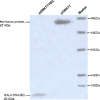Interaction between SARS-CoV helicase and a multifunctional cellular protein (Ddx5) revealed by yeast and mammalian cell two-hybrid systems
- PMID: 19224332
- PMCID: PMC7087151
- DOI: 10.1007/s00705-009-0323-y
Interaction between SARS-CoV helicase and a multifunctional cellular protein (Ddx5) revealed by yeast and mammalian cell two-hybrid systems
Abstract
To reveal the putative cellular factors involved in SARS coronavirus replication, the helicase (Hel, nsp13) of SARS coronavirus was used to screen the cDNA library of rat pulmonary epithelial cells using the yeast two-hybrid system. Positively interacting proteins were further tested using a mammalian cell hybrid system and co-immunoprecipitation in the human A549 cell line, which has been shown to support SARS coronavirus replication. Out of the seven positive clones observed by yeast two-hybrid assay, only the Ddx5 (Asp-Glu-Ala-Asp box polypeptide 5) protein showed specific interaction with SARS-CoV helicase. When expression of DdX5 was knocked down by small interfering RNA (siRNA), SARS coronavirus replication was significantly inhibited in fetal rhesus kidney (FRhK-4) cells. Since Ddx5 is a multifunctional protein that plays important roles in transcriptional regulation, its interaction with SARS coronavirus helicase provides interesting clues for studying virus-host cell interactions in SARS-CoV infections.
Figures



Similar articles
-
The DEAD-box RNA helicase 5 positively regulates the replication of porcine reproductive and respiratory syndrome virus by interacting with viral Nsp9 in vitro.Virus Res. 2015 Jan 2;195:217-24. doi: 10.1016/j.virusres.2014.10.021. Epub 2014 Nov 1. Virus Res. 2015. PMID: 25449571 Free PMC article.
-
The DEAD-box RNA helicase DDX5 acts as a positive regulator of Japanese encephalitis virus replication by binding to viral 3' UTR.Antiviral Res. 2013 Nov;100(2):487-99. doi: 10.1016/j.antiviral.2013.09.002. Epub 2013 Sep 12. Antiviral Res. 2013. PMID: 24035833 Free PMC article.
-
The cellular RNA helicase DDX1 interacts with coronavirus nonstructural protein 14 and enhances viral replication.J Virol. 2010 Sep;84(17):8571-83. doi: 10.1128/JVI.00392-10. Epub 2010 Jun 23. J Virol. 2010. PMID: 20573827 Free PMC article.
-
The Coronavirus helicase in replication.Virus Res. 2024 Aug;346:199401. doi: 10.1016/j.virusres.2024.199401. Epub 2024 May 31. Virus Res. 2024. PMID: 38796132 Free PMC article. Review.
-
DDX5 RNA Helicases: Emerging Roles in Viral Infection.Int J Mol Sci. 2018 Apr 9;19(4):1122. doi: 10.3390/ijms19041122. Int J Mol Sci. 2018. PMID: 29642538 Free PMC article. Review.
Cited by
-
Discovery of G-quadruplex-forming sequences in SARS-CoV-2.Brief Bioinform. 2021 Mar 22;22(2):1150-1160. doi: 10.1093/bib/bbaa114. Brief Bioinform. 2021. PMID: 32484220 Free PMC article.
-
The current landscape of coronavirus-host protein-protein interactions.J Transl Med. 2020 Aug 18;18(1):319. doi: 10.1186/s12967-020-02480-z. J Transl Med. 2020. PMID: 32811513 Free PMC article. Review.
-
System-Based Approaches to Delineate the Antiviral Innate Immune Landscape.Viruses. 2020 Oct 21;12(10):1196. doi: 10.3390/v12101196. Viruses. 2020. PMID: 33096788 Free PMC article. Review.
-
Melatonin: Regulation of Viral Phase Separation and Epitranscriptomics in Post-Acute Sequelae of COVID-19.Int J Mol Sci. 2022 Jul 23;23(15):8122. doi: 10.3390/ijms23158122. Int J Mol Sci. 2022. PMID: 35897696 Free PMC article. Review.
-
Human Helicase DDX5 is Hijacked by SARS-CoV‑2 Nsp13 Helicase to Enhance RNA Unwinding.ACS Omega. 2025 Jul 31;10(31):34941-34950. doi: 10.1021/acsomega.5c04271. eCollection 2025 Aug 12. ACS Omega. 2025. PMID: 40821550 Free PMC article.
References
Publication types
MeSH terms
Substances
LinkOut - more resources
Full Text Sources
Molecular Biology Databases
Miscellaneous

